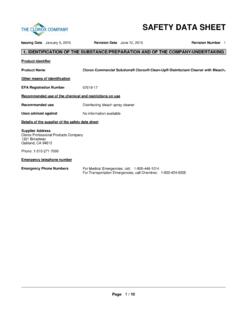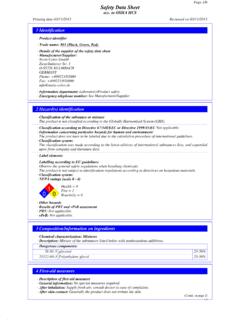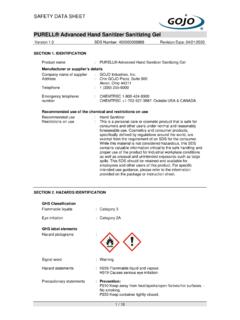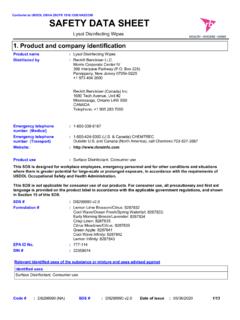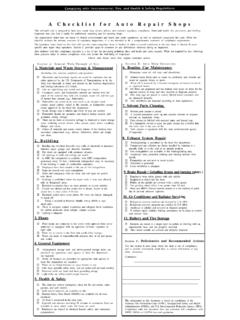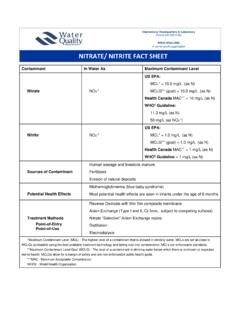Transcription of SAFETY DATA SHEET - content.oppictures.com
1 SAFETY data SHEET1. IdentificationProtection That Lives On Microban Professional Brand 24 Hour Keeps Killing 99% ofBacteria For Up To 24 Hours Sanitizing SprayProduct identifierOther means of identification30130-002 Product codeSanitizing SprayRecommended useNone restrictionsManufacturer/Importer/Suppli er/Distributor informationMicroban Products CompanyCompany name11400 Vanstory DriveAddressHuntersville, NC hr Emergency) 1-800-535-5053 or 1-352-323-3500 Emergency phone number2. Hazard(s) identificationLiquefied gasGases under pressurePhysical hazardsNot hazardsCategory 1 Hazardous to the aquatic environment, acutehazardEnvironmental hazardsCategory 1 Hazardous to the aquatic environment,long-term hazardNot defined hazardsLabel elementsSignal wordWarningHazard statementContains gas under pressure; may explode if heated.
2 Very toxic to aquatic life with long statementPreventionAvoid release to the environment. Observe good industrial hygiene spillage. Wash hands after from sunlight. Store in a well-ventilated of contents/container in accordance with local/regional/national/international (s) not otherwiseclassified (HNOC)None Composition/information on ingredientsMixturesCAS number%Chemical nameCommon name and synonyms7727-37-9 Nitrogen<168424-85-1 Quaternary AmmoniumCompounds,Benzyl-c12-16-alkyldim ethyl,Chlorides< / 7 Material name: Protection That Lives On Microban Professional Brand 24 Hour Keeps Killing 99% of Bacteria For Up To 24 Hours Sanitizing Spray30130-002 Version #: 04 Revision date: 05-September-2018 Issue date: 13-November-2017 SDS USCAS number%Chemical nameCommon name and synonyms7173-51-5 DIDECYL DIMETHYL AMMONIUMCHLORIDE< < First-aid measuresMove to fresh air.
3 Call a physician if symptoms develop or off with soap and water. Get medical attention if irritation develops and contactRinse with water. Get medical attention if irritation develops and contactRinse mouth. Get medical attention if symptoms contact with eyes may cause temporary importantsymptoms/effects, acute anddelayedProvide general supportive measures and treat of immediatemedical attention and specialtreatment neededEnsure that medical personnel are aware of the material(s) involved, and take precautions toprotect information5. Fire-fighting measuresWater fog. Foam. Dry chemical powder. Carbon dioxide (CO2).Suitable extinguishing mediaDo not use water jet as an extinguisher, as this will spread the extinguishingmediaDuring fire, gases hazardous to health may be hazards arising fromthe chemicalSelf-contained breathing apparatus and full protective clothing must be worn in case of protective equipmentand precautions for firefightersIn case of fire: Stop leak if safe to do so.
4 Do not move cargo or vehicle if cargo has been exposedto heat. Move containers from fire area if you can do so without risk. For massive fire in cargoarea, use unmanned hose holder or monitor nozzles, if possible. If not, withdraw and let fire fightingequipment/instructionsUse standard firefighting procedures and consider the hazards of other involved methodsContents under pressure. Pressurized container may explode when exposed to heat or fire hazards6. Accidental release measuresKeep unnecessary personnel away. Keep people away from and upwind of spill/leak. Keep out oflow areas. Many gases are heavier than air and will spread along ground and collect in low orconfined areas (sewers, basements, tanks). Wear appropriate protective equipment and clothingduring clean-up.
5 Emergency personnel need self-contained breathing equipment. Do not touchdamaged containers or spilled material unless wearing appropriate protective clothing. Ventilateclosed spaces before entering them. Local authorities should be advised if significant spillagescannot be contained. For personal protection, see section 8 of the precautions,protective equipment andemergency proceduresIsolate area until gas has dispersed. Prevent entry into waterways, sewer, basements or confinedareas. Stop the flow of material, if this is without risk. Absorb in vermiculite, dry sand or earth andplace into containers. Clean surface thoroughly to remove residual return spills to original containers for re-use. For waste disposal, see section 13 of the and materials forcontainment and cleaning upAvoid release to the environment.
6 Inform appropriate managerial or supervisory personnel of allenvironmental releases. Prevent further leakage or spillage if safe to do so. Avoid discharge intodrains, water courses or onto the precautions7. Handling and storageKeep away from heat/sparks/open flames/hot surfaces. - No smoking. Pressurized container: Donot pierce or burn, even after use. Do not use if spray button is missing or defective. Avoidprolonged exposure. Provide adequate ventilation. Wear appropriate personal protectiveequipment. Wash thoroughly after handling. Avoid release to the environment. Observe goodindustrial hygiene for safe handling2 / 7 Material name: Protection That Lives On Microban Professional Brand 24 Hour Keeps Killing 99% of Bacteria For Up To 24 Hours Sanitizing Spray30130-002 Version #: 04 Revision date: 05-September-2018 Issue date: 13-November-2017 SDS USLevel 1 container.
7 Protect from sunlight and do not expose to temperatures exceeding50 C/122 F. Do not handle or store near an open flame, heat or other sources of ignition. Store intightly closed container. Store in a well-ventilated place. Stored containers should be periodicallychecked for general condition and leakage. Store away from incompatible materials (see Section10 of the SDS).Conditions for safe storage,including any incompatibilities8. Exposure controls/personal protectionOccupational exposure limitsThe following constituents are the only constituents of the product which have a PEL, TLV or other recommended exposure this time, the other constituents have no known exposure OSHA Table Z-1 Limits for Air Contaminants (29 CFR )ValueComponentsTypePEL1900 mg/m3 Ethanol (CAS 64-17-5)1000 ppmUS.
8 ACGIH Threshold Limit ValuesValueComponentsTypeSTEL1000 ppmEthanol (CAS 64-17-5)US. NIOSH: Pocket Guide to Chemical HazardsValueComponentsTypeTWA1900 mg/m3 Ethanol (CAS 64-17-5)1000 ppmNo biological exposure limits noted for the ingredient(s).Biological limit valuesGood general ventilation (typically 10 air changes per hour) should be used. Ventilation ratesshould be matched to conditions. If applicable, use process enclosures, local exhaust ventilation,or other engineering controls to maintain airborne levels below recommended exposure limits. Ifexposure limits have not been established, maintain airborne levels to an acceptable engineeringcontrolsIndividual protection measures, such as personal protective equipmentWear SAFETY glasses with side shields (or goggles).
9 Eye/face protectionSkin protectionWear appropriate chemical resistant protectionWear suitable protective case of insufficient ventilation, wear suitable respiratory protectionWear appropriate thermal protective clothing, when hazardsAlways observe good personal hygiene measures, such as washing after handling the materialand before eating, drinking, and/or smoking. Routinely wash work clothing and protectiveequipment to remove hygieneconsiderations9. Physical and chemical properties AppearanceLiquid, stateLiquid. Liquefied water-white to Slightly thresholdNot - point/freezing pointNot boiling point and boilingrangeNot pointNot rateNot (solid, gas)3 / 7 Material name: Protection That Lives On Microban Professional Brand 24 Hour Keeps Killing 99% of Bacteria For Up To 24 Hours Sanitizing Spray30130-002 Version #: 04 Revision date: 05-September-2018 Issue date.
10 13-November-2017 SDS USUpper/lower flammability or explosive limitsFlammability limit - lower(%)Not limit - upper(%)Not limit - lower (%)Not limit - upper (%)Not pressureNot densityNot densityNot (ies)Solubility (water)Not coefficient(n-octanol/water)Not temperatureNot temperatureNot informationNot propertiesNot propertiesSpecific - Stability and reactivityThe product is stable and non-reactive under normal conditions of use, storage and is stable under normal stabilityHazardous polymerization does not of hazardousreactionsExcessive heat. Contact with incompatible to avoidStrong oxidizing materialsNo hazardous decomposition products are decompositionproducts11. Toxicological informationInformation on likely routes of exposureInhalationProlonged inhalation may be contactNo adverse effects due to skin contact are contactDirect contact with eyes may cause temporary to be a low ingestion related to thephysical, chemical andtoxicological characteristicsDirect contact with eyes may cause temporary on toxicological effectsAcute toxicityBased on available data , the classification criteria are not ResultsComponentsSpeciesDIDECYL DIMETHYL AMMONIUM CHLORIDE (CAS 7173-51-5)DermalAcuteLD50 Rabbit2730 mg/kgEthanol (CAS 64-17-5)InhalationAcuteLC50 Mouse39 mg/l, 4 Hours4 / 7 Material name.

